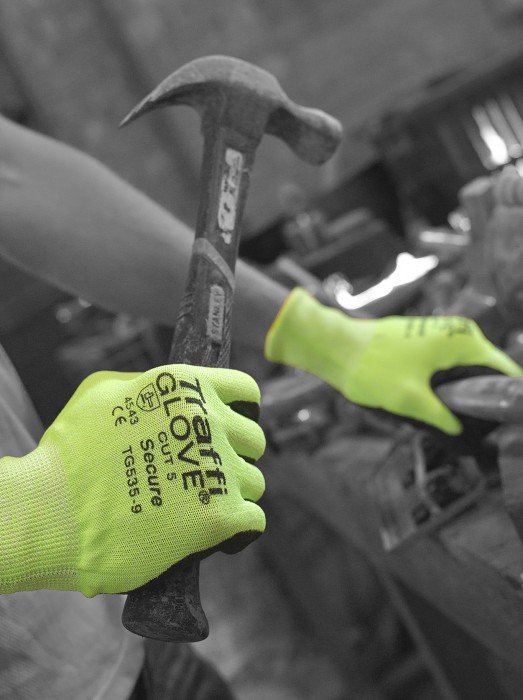Traffiglove: Tackling the issues at hand
 When it comes to ensuring the safety of employees, the number of considerations can seem almost limitless. Here at TraffiGlove, we’re familiar with this problem, which is why we’ve compiled our ‘Top Five’ hand safety issues to help you trouble shoot any PPE requirements you’re facing.
When it comes to ensuring the safety of employees, the number of considerations can seem almost limitless. Here at TraffiGlove, we’re familiar with this problem, which is why we’ve compiled our ‘Top Five’ hand safety issues to help you trouble shoot any PPE requirements you’re facing.
1. Hand injuries and skin complaints
Anyone suffering a skin complaint or an injury from what they have handled at work has implications for the business. Whether it’s a minor problem that keeps them away from work for a day or a more severe injury where the worker has to take extended leave, lost man hours have an impact on productivity.
Skin complaints can build up over time as a result of regular or persistent contact with potentially harmful substances, such as cement or peroxide. Abrasions, cuts, punctures and crush injuries are instantaneous and could be caused by machinery, sharp or rough edges, or heavy objects.
Preventing potential skin conditions and hand injuries can be done quite simply by drawing up a risk assessment of the job the worker is undertaking. This is an essential task to mitigate any risks, as it can help define what PPE is required for the job.
2. Dexterity when using correct gloves
Professions that include tasks such as electronics or carpentry need dexterous PPE in order for such jobs to be completed sufficiently. Safety gloves in particular are required to help reduce the risk of injury in such professions, however there are those who believe that they should sacrifice protection for improved dexterity by choosing a thinner glove or even not wearing gloves at all.
Such actions should be discouraged at all costs, not only because there are now gloves that offer both excellent protection and dexterity, but the agility of the hand and fingers can also be severely compromised if they become injured. At TraffiGlove, our cut level one (red) range contains a number of gloves, such as the TG122 Agile, that are suitable for painters and decorators and electricians, as their comfort and dexterity allow for smooth and safe job performance.
3. Glove life
Crucially, knowing when a pair of gloves is no longer suitable for use can stop injuries. However, in many instances, businesses will discard perfectly good gloves because they are dirty, but provided they’re undamaged, they can easily be cleaned and used again. Not only does this save money, but it also reduces unnecessary waste.
Gloves that are beginning to show signs of wear and tear could lead to an injury for the wearer. Making sure they are inspected on a regular basis can help ensure they are working properly and that the wearer is at no risk of a potential injury due to ineffective PPE, which could rest on the company’s shoulders depending on the severity of the injury sustained.
4. Understanding Hand Safety Standards
Relaying the message about hand safety and the steps that can be taken to reduce injuries can often be regarded as an expensive or time-consuming exercise, but simple steps such as display posters can be effective at raising the profile of hand safety.
During a recent trial with Crossrail, we printed safety messages on the back of gloves to help workers consider hand safety as a priority – simple actions like this can easily remind workers of the importance of health and safety in the workplace.
5. Compliance
Making sure employees comply with health and safety regulations can be a concern for senior managers. Serious accidents can occur if health and safety best practices, aimed at protecting everyone within the working environment, are not adhered to by individuals.
Training, on-the-job prompts and reminders can be essential to compliance. Other ways to improve compliance include risk assessments, sufficient information relaying, training and instruction on top of regular PPE inspection. Introducing risk assessments before a job is started enables the assessor and worker to understand what safety gloves are best to use.
At TraffiGlove, we recommend a ‘Check 5’, which can make sure that workers’ hands are fully protected from irritants and injuries. Firstly, it’s important to understand the actual risk open to workers’ hands. Secondly, check the environmental conditions – are they wet or dry? Thirdly, knowledge of the hazards being handled is also essential – are they sharp or rough? If it’s liquid, will it harm the skin? It is then vital to measure hand size, so any gloves being worn will fit the user properly. Finally, make your glove selection based on the four previous checks.
With our TraffiSafe colour coding system, you can be sure to find the right glove for the task at hand. Our different cut levels cover a variety of jobs, with our cut level one gloves (red) suitable for general handling tasks, our cut level three (amber) gloves, which are suitable for second fix construction trades and our cut level five (green) gloves, designed for higher risk tasks which may involve hazardous materials.
Traffiglove: Tackling the issues at hand
When it comes to ensuring the safety of employees, the number of considerations can seem almost limitless. Here at TraffiGlove,
Safety & Health Practitioner
SHP - Health and Safety News, Legislation, PPE, CPD and Resources Related Topics
Hundreds of workplace buildings to be inspected for safety this week
Inclusivity in PPE: The manufacturer’s perspective
Future-proofing safety: Five trends shaping the PPE landscape of tomorrow

